Hatching
Chicks first "pip" by poking a small hole in the egg. They then chip at the shell until they can push off the top. Chicks take up to three days to chip their way out.
Fine down feathers cover most newly hatched chicks. (King penguin chicks hatch naked and grow down feathers within a few weeks.)
-
Down feathers of different species may be white, gray, black, or brown.
- Down feathers are not waterproof, and chicks must remain out of the water until they acquire their juvenile plumage.
- Adult plumage is acquired at about one year.
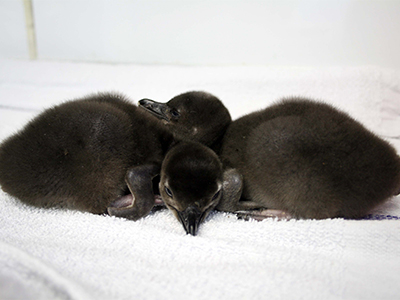
In all species, the coloration and markings of chicks separate them from adults. Scientists believe that the chicks' coloration elicits parental behavior from the adults, and that adult penguins do not perceive the young birds as competitors for mates or nesting sites.
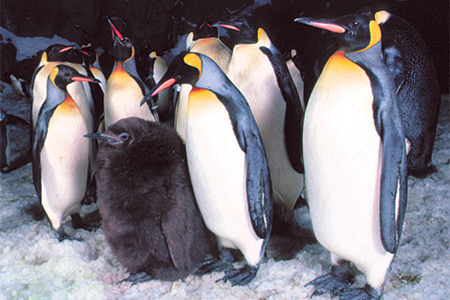
The striking markings of emperor chicks may help to make the chicks more visible against the ice and snow, significant because emperors don't have individual nest sites where the young can be found.
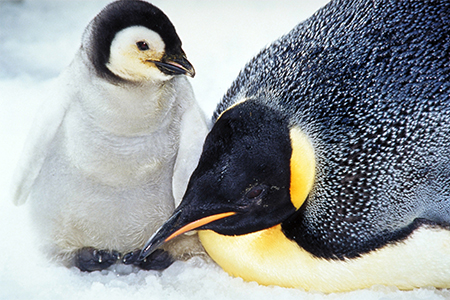
Care of the Chicks
Chicks require attentive parents for survival. Both parents feed the chick regurgitated food. Adults recognize and feed only their own chick. Parents are able to identify their chick by its distinctive call.
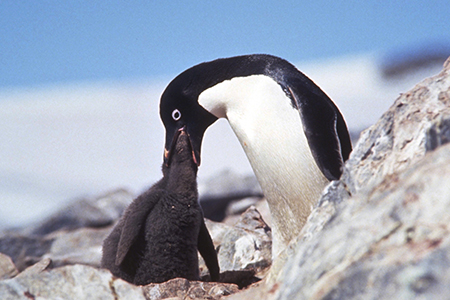
Penguins feed their chicks regurgitated food.
During fieldwork at the Falkland Islands, a researcher observed a behavior never witnessed before—an older gentoo chick was recorded several times regurgitating food and feeding its younger sibling. It is not understood why the older chick would feed its younger sibling, as in theory such an action would likely reduce the older chick's chances of survival.
Male emperor penguins exhibit a feature unique among penguins. If the chick hatches before the female returns, the male, despite his fasting, is able to produce and secrete a curdlike substance from his esophagus to feed the chick, allowing for survival and growth for up to two weeks.
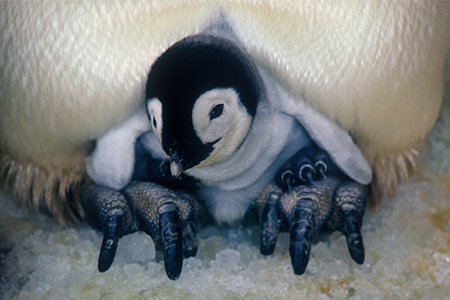
Parents brood chicks (keep them warm) by covering them with their brood patch.
In some species, partially grown chicks gather in groups called crèches. (Crèche is a French word for crib.)
-
Crèches provide some protection from predators and the elements.
- Crèches were once thought to be functional nurseries with adults providing protection and communal care. This has proven not to be the case. Parents feed only their own chick.
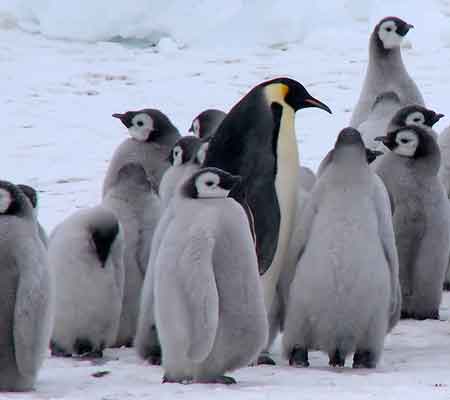
- King chicks are believed to form crèches for protection against harsh weather, predation, and aggressive, non-related adults.
- The preferred place for a king penguin crèche to form is in the central parts of the colony.
- A contributing factor for king chicks to join a crèche comes from harassment by non-related king penguin adults—lone chicks suffered the most aggression by non-related adults with those that had joined a crèche suffering the least.
- The outer edges of a crèche are the most vulnerable to predation, and king chicks at the periphery appeared to be more vigilant when resting based on measuring the time they kept their eyes open.
- At times intense competition flared between chicks for access to the center of the crèche. Chicks in the poorest health were pushed to the edges of the crèche where they were preyed upon by giant petrels.
- When weather turned severe, king chicks formed larger, more condensed crèches. Spacing between individual chicks decreased and the chicks turned their backs to the wind and rain.
- Temperate or subtropical crested penguins, like the macaroni or erect-crested, and penguins that nest in burrows, like the little or Humboldt, do not form crèches.
Chick "adoption" and "kidnapping"
During a two year study of emperor penguins in Antarctica, mainly non-breeding adult females and failed breeding female emperors often "kidnapped" and attempted to "adopt" chicks that clearly were not their own.
-
Out of 2,068 chicks hatched in the colony in 1993, adoption occurred in 351 cases. Adoption took place 185 times out of the 351 cases (53%) after the kidnapping of a chick or where a chick was found wandering around the colony. Chicks were one to two months old.
- Most adoptions were short-lived events, lasting an average of 0.5 to 10 days. Attempts to feed the adopted chicks were seen in a minimum of about 15% of the cases (52 out of 351.) Long-term adoption was seen in only about 2% of the cases.
- Most adoption attempts ended badly for the chick. "Readoption" of a chick to its true parents was only seen in rare instances where the chick was taken close to its true parents but was quickly abandoned by its kidnapper.
In contrast to most bird species, penguins generally maintain high levels of the hormone prolactin (PRL) throughout their entire breeding season, even those that may lose their eggs or chicks.
-
PRL is also referred to as the "parenting hormone" for its connection in maintaining the strong bond between a chick and parents. The kidnapping behavior witnessed in adult emperor penguins is believed to be a result of high levels of PRL.
- Emperor adults that had their PRL levels artificially decreased (by the administration of bromocriptine) kidnapped chicks at a lower level than those that maintained higher levels of PRL.
At least 65 bird species have been known to "adopt" the young of a different species, including one instance where a king penguin attempted to raise a brown skua chick.
-
Adult brown skuas are natural enemies of king penguin chicks. Brown skua chicks, however, are brown with fuzzy down that may superficially resemble a newly hatched king penguin.
- A king penguin adult was seen pushing a brown skua chick onto its feet, apparently attempting to brood the skua as it would a newly hatched king penguin chick.
- Both skua parents attempted a rescue by harassing the penguin. Twice they succeeded in taking their chick back, however, the determined king fought back and retook the chick by beating its flippers and pecking at the parents. Human intervention by one of the observers finally ended the conflict and the chick was returned back to its real parents.
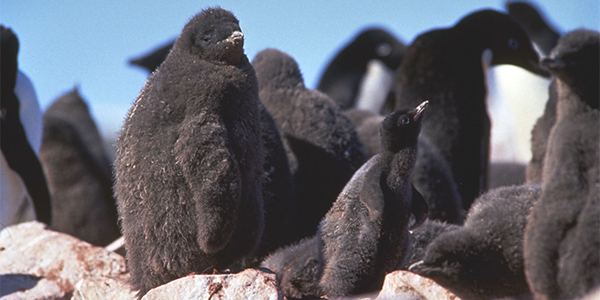
Chick Development
A chick depends on its parents for survival between hatching and the growth of its waterproof feathers before it can fledge (leave the colony to go forage at sea.)
-
This period may range from seven to nine weeks for Adélie chicks to 13 months for king penguin chicks.
- For most penguin species, once a chick has replaced its juvenile down with waterproof feathers it is able to enter the water and becomes independent of its parents.
- Some juvenile gentoo penguins that have undergone a complete molt, leave the colony to forage at sea during the day but return to the colony with some still receiving food from their parents for an average of 12 days following their first foraging trip at sea. Following this period of extended parental care the gentoo fledglings disperse from the colony.